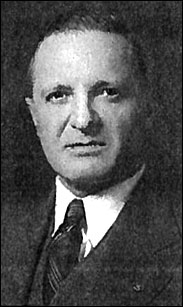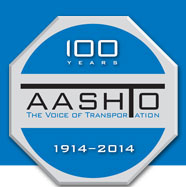
February 29, 2014
AASHTO Presidential Profile: Michael J. Hoffmann, Minnesota Highway Department

Michael J. Hoffmann of Minnesota served as AASHO president in 1946, in an era when both the association and the United States were moving further away from the World War II years and beginning to grapple with the major peacetime challenges facing the nation's highways. As one benchmark of those post-war challenges, vehicle registrations and traffic nationwide had jumped significantly in the time since the Axis powers were defeated.
Hoffmann was born on Feb. 20, 1889, in Saint Paul, Minn. He graduated from the University of Minnesota with a degree in engineering and embarked on his career in that field in 1913 with the Milwaukee Railroad. Hoffmann's highway engineering began the following year, when he joined the Minnesota Highway Department as a bridge draftsman.
Hoffmann served in that position for two years and during that time worked on surveys. In 1917, he was appointed district engineer in northwestern Minnesota. His career was put on hold following the U.S. entry in World War I, when he joined the U.S. military and served overseas with the renowned 42nd Rainbow Division. Hoffmann’s duties with that division specifically involved serving in a special contingent of engineers that helped maintain transportation lines along a section of the Western Front in France.
In 1919, Hoffmann rejoined the Minnesota Highway Department as the district engineer in charge of operations in southeaster Minnesota. He became the assistant maintenance engineer in the Minnesota Highway Department's central office in 1921. In 1921, Hoffmann was appointed chief bridge engineer. In that capacity, he supervised the design and construction of approximately 1,400 bridges statewide. Hoffmann was appointed Minnesota's Commissioner of Highways in January 1939 by Governor Harold E. Stassen, and in the process assumed responsibility not only for the state's many bridges but its 11,350 miles of highways.
Hoffmann also became active in AASHO activities as far back as the mid-1920s. He served as a member of the association's Executive Committee starting in December 1942, and became first vice president in February 1942. In January 1946, Hoffmann was elected president at AASHO's annual meeting in Oklahoma City, Oklahoma. (There was no annual meeting the previous calendar year, with a total of two annual meetings held instead in 1946.)
As president, Hoffmann had to deal with various states trying to mount viable post-war construction programs in the face of such obstacles as nationwide labor-management struggles and increased road-building costs. While characterizing available federal funds for state-level efforts as "a good start," he also asserted that "from the standpoint of highway needs, it admittedly is only a start toward rehabilitation of our highway system."
Hoffmann's tenure, which came to an end in December of that year at the AASHO annual meeting in Lose Angeles, also marked a time during which such issues as federal-aid apportioning formulas and toll roads were heavily discussed by the association. It was also during Hoffmann's time as president that the Highway Safety Conference organized by the Truman Administration was convened to address the magnitude of deaths, injuries, and property damage taking place along highways across the nation. Approximately 2,000 participants -- including federal, state, and local officials, civic leaders, highway transportation and traffic technicians, and leaders of various national organizations – gathered for that conference in Washington, D.C.
AASHO members played a major role both at the conference itself and in a host of subsequent related activities. "Highway officials in many states are presently giving leadership and support to follow-up conferences and to other activities designed to make our roads and streets safer," said Hoffmann. "The safety problem demands full and active participation by all state highway departments."
After stepping down as president, Hoffmann continued to serve on the Executive Committee until November 1956. He was awarded the George S. Bartlett Award for his highway achievements in 1950. Hoffmann retired from the position of commissioner in April 1957, serving the agency as a consultant until 1962. He died in St. Mary's Hospital in Minneapolis on Dec. 18, 1967, at the age of 78.












